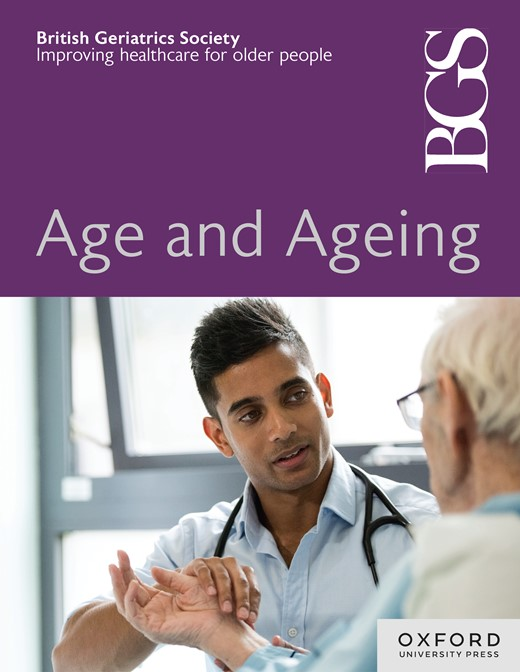老年人综合护理团队中的营养不良风险筛查和营养师干预措施
IF 6
2区 医学
Q1 GERIATRICS & GERONTOLOGY
引用次数: 0
摘要
背景 老年人营养不良会增加身体虚弱的风险。营养干预可以改善虚弱状况。2022 年,一名高级营养师加入了我们的老年人社区综合护理专家小组(ICPOP-CST)。2023 年初,我们重新设计了老年人全面评估(CGA)表格,其中包括营养不良筛查工具(MST)。2023 年底,我们开始测量手握力(HGS)。我们测量了患者营养不良风险的发生率,审核了营养不良筛查工具的使用情况,并探讨了营养师服务的提供情况。方法 我们从该服务的患者电子数据库中获取了首批 101 名填写完整(新)CGA 表格的患者的数据。MST评分为0或1分的患者被视为营养不良低风险患者,MST评分为2分或以上的患者被视为营养不良高风险患者。结果 平均年龄为(84.8±5.3)岁,65%为女性。39名(38.6%)患者被确定有营养不良风险。96名(95%)患者完成了 MST,67名(69.8%)患者正确完成了 MST。在 29 份填写错误的筛查工具中,有 26 份(89.7%)的总分没有相加。半数(51,50.5%)老年人接受了营养学评估和干预。ICPOP 营养师为其中的 38 人(74.5%)和 29 人(93.5%)提供了高蛋白、高热量建议。在 ICPOP 营养师接诊的患者中,有 14 人(27.5%)被转诊至初级保健营养师。对 20 名患者进行了 HGS 测量,其中 15 人(75.0%)被确认可能患有肌肉疏松症,11 人(73.3%)有营养不良的风险。所有患者都接受了与蛋白质和肌肉疏松症有关的饮食干预。结论 在转诊至 ICPOP-CST 团队的老年人中,营养不良风险和可能的肌肉疏松症很常见。营养不良筛查工具非常实用,可识别出需要营养干预的人群。本文章由计算机程序翻译,如有差异,请以英文原文为准。
Malnutrition Risk Screening and Dietitian Intervention within an Integrated Care Team for Older Persons
Background Malnutrition in older adults increases the risk of frailty. Nutritional interventions can improve frailty. A Senior Dietitian joined our Integrated Care for Older Persons Community Specialist Team (ICPOP-CST) in 2022. Our Complete Geriatric Assessment (CGA) form was redesigned in early 2023 which included the Malnutrition Screening Tool (MST). We commenced measuring handgrip strength (HGS) in late 2023. We measured the prevalence of malnutrition risk among our patients, audited MST use and explored dietetic service provision. Methods Data from the first 101 patients with a completed (new) CGA form were obtained from the service’s electronic patient database. Patients with a MST score of 0 or 1 were considered to be at low risk of malnutrition and those with a MST score of 2 or more were considered to be at risk of malnutrition. Results The mean age was 84.8±5.3 years and 65% were female. Malnutrition risk was identified in 39 (38.6%) patients. The MST was completed for 96 (95%) patients and completed correctly in 67 (69.8%). The total score was not summed in 26 out of 29 incorrectly completed screening tools (89.7%). Half (51, 50.5%) of the group of older adults received dietetic assessment and intervention. High protein, high calorie advice was provided for 38 (74.5%) of those seen by the ICPOP dietitian and for 29 (93.5 %) of those at risk of malnutrition. Onward referral to primary care dietitians was made for 14 (27.5%) of those seen by the ICPOP dietitian. HGS measurement was performed in 20 patients - 15 (75.0%) were identified to have probable sarcopenia – 11 (73.3%) of these were at risk of malnutrition. All received dietetic intervention in relation to protein and sarcopenia. Conclusion Malnutrition risk and probable sarcopenia are common among older adults referred to our ICPOP-CST team. The MST screening tool is practical and identifies those requiring dietetic intervention.
求助全文
通过发布文献求助,成功后即可免费获取论文全文。
去求助
来源期刊

Age and ageing
医学-老年医学
CiteScore
9.20
自引率
6.00%
发文量
796
审稿时长
4-8 weeks
期刊介绍:
Age and Ageing is an international journal publishing refereed original articles and commissioned reviews on geriatric medicine and gerontology. Its range includes research on ageing and clinical, epidemiological, and psychological aspects of later life.
 求助内容:
求助内容: 应助结果提醒方式:
应助结果提醒方式:


